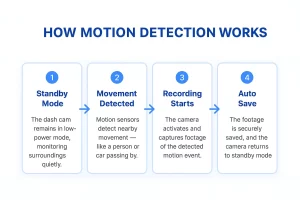A dash cam with motion detection turns your parked car into a silent 24-hour security guard. It only records when movement is detected nearby—saving power, preserving memory, and keeping your vehicle protected even when you’re not around.
| Feature | Function | When Active |
|---|---|---|
| Motion Detection | Records when movement is detected | When the car is stationary |
| Parking Mode | Monitors surroundings continuously | When ignition is off |
| G-Sensor | Activates during impact | During collisions or bumps |
What Is Motion Detection in Dash Cams?
A dash cam (dashboard camera) is a digital recording device that captures what happens around your vehicle while driving or parked. Modern devices like the SEEWORLD V7 Pro Dash Cam integrate intelligent features such as radar-assisted motion detection, night vision, and Wi-Fi connectivity, making them advanced camera systems for cars.
The motion detection feature—sometimes called a motion sensor dash cam—uses built-in sensors to detect nearby movement. When a person, car, or object enters the detection area, the camera automatically begins recording, ensuring no crucial event goes unnoticed.
Why Motion Detection Matters: The Main Benefits
1. 24/7 Vehicle Security
A motion detection car camera works even when your ignition is off. It functions as a car motion detector camera, providing reliable monitoring for vandalism, hit-and-run incidents, or theft.
Example: If someone bumps into your car while reversing, your dash cam automatically records the event, serving as visual evidence for police or insurance claims.
This is why many drivers prefer a dash cam that records when the car is off—it offers continuous protection without constant manual operation.
For deeper insight into related features, see:
👉 Does a Dash Cam Drain Your Car Battery? What You Need to Know
2. Smarter Energy and Storage Management
Unlike continuous recording, a motion-activated dash cam only records relevant moments.
This helps:
-
Preserve your car’s battery life
-
Save storage space
-
Minimize unnecessary video files
High-end models like the V7 Pro also use intelligent auto motion sensors to balance sensitivity and efficiency—recording only when motion is meaningful.
3. Automatic, Hands-Free Operation
In older devices, users had to manually enable motion detection after parking. But now, modern dash cams with motion sensors automatically detect when the car is parked and activate recording.
This convenience stems from advanced automotive motion sensors and radar-assisted detection systems, which intelligently differentiate between moving cars, pedestrians, and minor background motion.
📊 Compare old vs. new dash cam operation:
| Old Dash Cams | Modern Dash Cams (like V7 Pro) |
|---|---|
| Manual setup required | Automatic motion activation |
| Limited sensitivity control | AI + radar detection |
| No night vision | Infrared night vision for 24/7 coverage |
4. Integration with Parking Mode
Many advanced devices combine motion detection with a broader parking mode system, which also includes G-sensor and time-lapse triggers.
In essence:
-
Parking mode = multiple event triggers
-
Motion detection = one of those triggers (activated by movement)
This mode keeps your vehicle secure even in public parking lots or garages, making it an essential part of any car security motion sensor system.
To learn how such telematics systems improve fleet-level security, explore:
👉 Understanding Telematics: A Comprehensive Guide for Fleet Management
How Motion Detection Works
Here’s how a motion detection dash cam operates step-by-step:
-
Standby Mode:
When parked, your dash cam enters low-power mode, monitoring its surroundings. -
Movement Detection:
A built-in motion sensor camera for a car detects nearby movement, such as a person or vehicle. -
Recording Activation:
The system begins recording and stores the footage securely. -
Return to Standby:
Once no motion is detected, it stops recording automatically.
Motion Detection vs Parking Mode
Many users confuse these terms. Here’s the key difference:
| Feature | Trigger | Recording Style | Use Case |
|---|---|---|---|
| Parking Mode | Ignition off / G-sensor / Timer / Motion | Continuous or event-based | Long-term surveillance |
| Motion Detection | Movement only | Event-based (short clips) | Power-saving recording |
In short, Parking mode is the full system; motion detection is one of its smart triggers.
For dash cams with Wi-Fi capabilities, you can easily access or share these recordings remotely. Learn more here:
👉 What Is Wi-Fi Used for on a Dash Cam and How Does It Work?
When to Use Motion Detection
Activate motion detection when:
-
Parking in open or high-risk areas
-
Leaving your vehicle overnight in a garage
-
Traveling or parking in unfamiliar locations
Avoid using it while driving, as everything in view is in motion, which may cause continuous activation. Instead, switch to standard recording or radar-assisted driving cameras with Mwave radar for motion-aware precision.
Pro Tips for Best Results
| Do | Don’t |
|---|---|
| Enable motion detection in parking mode | Use it while driving |
| Use a hardwire kit for constant power | Rely only on the dash cam battery |
| Adjust sensitivity to reduce false alerts | Leave sensitivity too high in windy areas |
| Choose a dash cam with night vision for better clarity | Ignore low-light recording capabilities |
Conclusion
The dash cam motion detection feature transforms your car into an intelligent security system that detects movement and records only when necessary.
Whether it’s preventing theft, capturing hit-and-run incidents, or simply offering peace of mind, a motion detection car camera—especially one like the SEEWORLD V7 Pro Dash Cam—ensures your vehicle is watched over 24/7 with clarity and precision.




